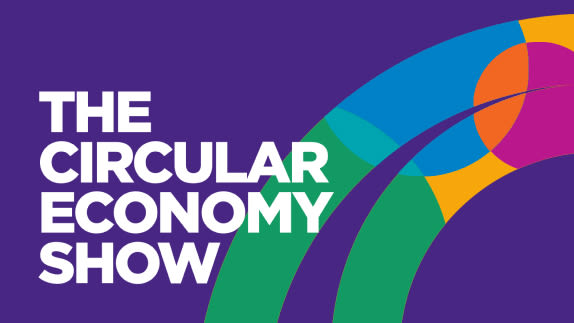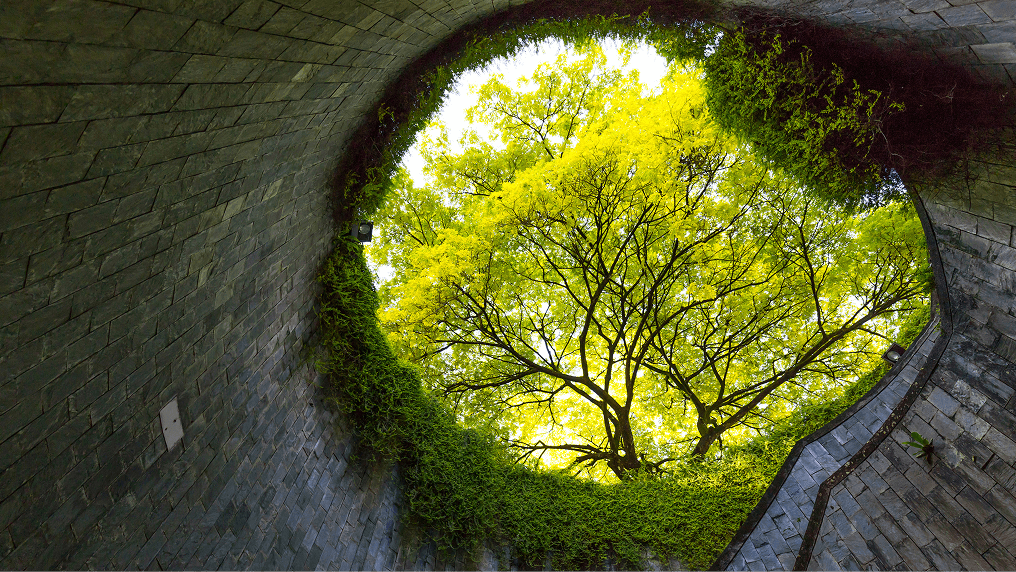When we talk about the circular economy, we often think about the technical aspects of transitioning away from the linear economy. In this episode, the artist Es Devlin talks to curator and author Francesca Gavin about the power of art to inspire change.
Listen on Spotify, Apple Podcasts, or wherever you get your podcasts
Transcript
Click to expand
Pippa Shawley 0:03
What do a Beyoncé tour, the 2012 Olympic closing ceremony and COP26 have in common? They’ve all featured the work of the artist Es Devlin. Es started out working in theatre, but is best known for public works that provoke and inspire the imagination. I’m Pippa, and on this episode of The Circular Economy Show Podcast, we’re sharing a conversation between Es and curator and author, Francesca Gavin. The pair spoke at the Ellen MacArthur Foundation’s Summit23, a gathering of the Foundation’s network of businesses, policymakers, philanthropic organisations, and institutions, to accelerate the transition to a circular economy. In this session, Francesca and Es discuss how the creative industries can lead and support positive change and influence human behaviour. Francesca began by asking Es why arts and culture are so vital to the existence of humans.
Es Devlin 0:56
What I think first, just looking at this beautiful gathering in a circle, and recognising that in what we do daily, this becomes I think, rarer and rarer this gathering. Phones off or focused on a couple of people talking, this becomes more and more precious. And I think when we're gathering to tell each other a tale, we shift our experience of time. Something that the wonderful choreographer, Akram Khan, said to me during the lockdown when I asked him 'what are you missing most while theatre is temporarily extinct?' And he said, I missed the way that time passes when I'm on a stage. Because I put away clock time. And I engage with a deeper ocean time I engage with a time that's about storytelling time, a time that's from your mother's womb time, different time. And we engage in that in very precious few moments. And when we do engage in it, we realise something Carmody Michael, you might know, Carmody, Grey, sorry, a wonderful theologist. She was talking about sustainability. And she said to us gathered at a talk with her. She said sustainability, clearly very important, but what are we sustaining? What type of life? What type of quality of engagement? Do we actually want to sustain? Let's ask ourselves that. And I think this type of gathering, listening, phones off to what we're saying is a gorgeous thing to sustain.
Francesca Gavin 2:30
I think another one I can come back... And another thing that I really think of as a curator and a writer, is the importance of narrative and metaphor. I think so many times we live in a world where we are formed by our narratives. If you even think going back to something like Aristophanes, or like ancient Greek myth, these are like the archetypes that have fundamentally formed how human beings see themselves and how they function in the world. In particular, our relationship to nature is very much formed by the Enlightenment and this differentiation between the human and the natural world. And I'm curious, from your experience, what your feelings are about how to find new narratives and new metaphors and that role?
Es Devlin 3:12
I think also seeing as the Greeks did the theatre as a rehearsal society, you know, that was the purpose of the Greek theatre was to rehearse situations so that those in the audience will be better prepared to encounter them. And some of the work that I've done, I was talking to you earlier about with the London Wildlife Trust, when I asked them specifically, what could an artist do to support their work? He said, Look, we can help with Habitat Conservation, and getting involved in policy and planning. But what we want artists to do is to make a habitat for non human species within the imagination of the humans. And it's just a basic thing that every time a species comes within your path, if you even know its name, then you make a room for it in your imagination. And that basic piece of just allowing habitats in the imagination is actually critical to the prevention of extinction of non human species.
Francesca Gavin 4:13
Yes, I think also... that's really I mean, I've done a lot of exhibitions around mushrooms, which have been immensely popular, like 1500 people came a day to see a mushroom show, which is quite a weird thing. But I think again, it's this need for looking... becoming aware that we are within a wider world. I know you've worked in that project with I don't think he said there were 15,000 different species in humans were only one is that correct?
Es Devlin 4:36
It was...it was an interesting question, because often I'm invited to make work that isn't about the nonhuman or the more than human, I'm often invited to make work around humans. So someone said to me, will you make a piece about London? And I said, Well, what about... Let's examine, you know, the species of Londoners. And of course, there are 15,000 species of Londoners, of which one is human. So that was quite an important thing. I think the other thing is, more broadly. I mean, Andrew, and I talk about this quite a lot, is cognitive shift, behavioural shift. I think we often... I remember in 2018, having read the latest IPCC report, my studio and I became a little despairing. And we asked ourselves, would we ever as humans really be able to make the types of cognitive behavioural shifts that were necessary this was, of course, before COVID. Before we'd seen everybody put a mask on overnight. And we thought, what if we make a map of all the times in history that we really did make, as humans, a huge cognitive shift. So you start with the room in which Copernicus redrew the map of the universe, and then you go to the room on the boat, where Darwin redrew our position within the biosphere, and then you take the railings, to which Emmeline Pankhurst chained herself, then you take the bus on the street, the seat which Rosa Parks refused to give up, and then maybe the steps where Greta Thunberg sat down. And if you locate those places in your imagination, suddenly you start to build a map of the world of possible huge cognitive shift that we've done before. And many of you may know the work of Joanna Macy, the extraordinary systems theorist and climate activist who's 93 years old now, I believe. And she says, yes, this behavioural shift that we need to engage in, is huge. And we've normally taken a generation or so to make such a behavioural or cognitive shift. And we just have to do this one, consciously, rather than unconsciously, and in 30 years, rather than two generations.
Francesca Gavin 6:41
I think also something that you really touch on even when you're naming those kinds of examples is the importance of art and culture, in particular, for having an emotional connection with an audience. Because facts don't necessarily do that in the same way. I mean, we can everyone's seen lists of facts, and we all have a list. But there's something about placing that within an installation, within a film, within a painting, whatever medium it is, that do you agree creates more of an emotional resonance?
Es Devlin 7:12
I mean, this is another thing from Carmody's talk. She gave the example of her friend who had smoked for years, and everyone had said to her daily stop smoking, stop smoking, stop smoking. And then she got pregnant, felt different, stopped smoking the next day. No, no fact was ever going to change this person's behaviour, just how she felt. And we I mean, that's been proven by endless studies, that people's behaviour doesn't change from being given facts, so much from how you feel. And feelings is something that in the arts, we've spent our time developing the magic of that and this is this magic story I wanted to tell if I may. f you've read the beautiful Merlin Sheldrake book, Entangled Life, he tells this story around page 10, about the fantastic.... which you must also read, David Abrams, the eco philosopher, sleight of hand magician. So David Abrams is doing coin and card tricks, and he's doing them at a table of diners in a restaurant in Massachusetts over a period of weeks, five different groups of diners complained to the management and they say David Abrams, this conjurer is spiking our drinks, because when we come out of the restaurant, the sky is a really weird blue. And it's doing these weird, sort of movements. And all the posters on the streets are all kind of dancing around. He's definitely spiking our drinks. Five different people say this. And David Abrams says no, because I've destabilised your expectations about how coins and cards behave, I've destabilised your expectations about how blue the sky is, or how interesting the posters are. And therefore, instead of looking at the sky, with a preconceived idea of the blueness of it, you're really looking at it. And that is so crazy. You think you've been drugged. So so that quality of magic, and Timothy Morton says this, when he wrote his sort of manifesto for artists, the eco philosopher Timothy Morton, I'm sure you're familiar with. He said, Look, please, artists, please don't preach. We've had enough preaching, please don't preach, don't educate, just please do some magic. Please amaze us into changing our mind and our behaviour. So I think, in the theatre, in art galleries, we have been practising that type of operation in those areas where you can get through the chinks in the armour of a person's preconceived ideas, sometimes.
Francesca Gavin 7:12
I'm thinking about a lot of the great artworks of the 20th century that are narrative-based, a lot of them, let's say, within a climate context, have highlighted the dystopian, the negative, the horror stories. I mean, lots of wonderful science fiction has come out of that. However, do you think there's a shift that's possible for more positivist visions of what the future can be, that can be presented by art and culture?
Es Devlin 9:59
I think both are equally useful. But I would say what, whenever I engage with a work of art, I want to feel a sense of where do I go when I exit the work of art? Where does it point me? Maybe it's a reaction against something that's a dystopian future. Or maybe it's in reaction towards an imagined possible future. I mean, Margaret Atwood's very useful on this, I think, she doesn't call her work 'science fiction', she calls it possible futures. And I think they're often dystopian, but they're sometimes also seeds of futures that we might want to try and work towards.
Francesca Gavin 10:41
One of the things I think is amazing about your work, if anyone gets the opportunity to see it, is scale and spectacle. You work really big, you think really big, you're not afraid of that. What do you think is useful about, sort of, creating things on that kind of big scale in a way that connects people?
Es Devlin 10:59
I mean, I think I got used to big scale, because I work with singers who sing in big spaces. And I guess I got a taste for what it feels like, I also went to church a lot when I was a kid. So my earliest memories were singing together in a church and the props and the little bells you had to do it at a certain time. And the idea that you have a script, as an audience, it's, it's easy to talk about participation in artworks, but it can feel very uncomfortable if you are an audience, but you don't know what your part is. And for better and, and worse, the church at least gave you a little piece of paper with the red bits were the bits you have to say. So I do think that type of model, for me, then expanded into being in stadia of like 100,000 people all singing a Beyonce song. And I liked how it felt when we were all singing the same song. Sometimes acapella. I remember at Glastonbury, 250,000 people all singing Someone Like You the day after the Brexit referendum results, and everybody weeping because it was a ritual place that we could all emote together. And again, coming back to what do we want to sustain about being human? That's one of the things I would like to sustain.
Francesca Gavin 12:17
I mean, I would also I always argue that places like the Tate, in a way, are the contemporary version of cathedrals
Es Devlin 12:23
Yes
Francesca Gavin 12:24
And that we, as viewers, are looking for profound experiences. We still watch every... everyone's watching television for narratives that we want to connect to. We want to see things that live out different ways of being... make us make make ideas of different ways of being seen possible or of existence.
Es Devlin 12:42
I think something Joanna Macy talks about her phrase 'come home again', really comes from, she says, "now we can relinquish our isolation, we can come home to our mutual belonging." And the way she sees it is a process of separation of the ritual that was the gathering of scent, sound, light, song, in the great ritual spaces of the past, being siloed out, sort of, at the time of the enclosures, one might say, you're enclosing the commons and you're enclosing the imagination. You're taking the scent out and putting it in a bottle, you're taking the art out and put it in a white cube gallery. You're taking the music out and put it on a record. So that synesthetic ritual experience is something that is innate in our bodies, and it's this little fraction of history that we happen to be living through, where we haven't done that. So I think returning to a sense of being connected with the rest of the biosphere, and one of the pieces that may or may not be flicking up, because I can't see them all. It's a piece called Forest of Us that I made...
Francesca Gavin 13:41
I was gonna bring it up, actually, I think.
Es Devlin 13:42
Yeah, it's on in Miami, it's still on. And it was based out of a really simple observation. Because I didn't really study science very much when I was a kid. Most of you who understand science at all may find this a really banal revelation. But to me, it was exciting. When I read James Gleick's book, Chaos, which was written in 87. And I really recommend anyone who's not read it to read it, he just sort of revealed to me that there is a bifurcating equation that kind of governs everything that looks similar that you kind of suspect it's connected. So the way that your arteries divide, the way that any tree bifurcates, the way that water bifurcates, when it rolls down your windscreen. And if you get into it, the way that the stock exchange variables happen, all of these, as many of people who read this book know, are all based on the same kind of maths. So when you look at an - ray of your own lungs, they look exactly like a pair of trees. And of course they would, because they're just a gas exchange mechanism being effective, just exchanging carbon dioxide, for oxygen. And anyone who studied biology knows that, but I hadn't, and I didn't. And I thought, well, if I haven't, maybe a lot of people haven't. So the piece of work that I made is a really short, two and a half minute film, a bit like an advert. But it's not selling you anything you have to buy, it's selling you this idea that you might remember. And whenever you then look at a tree or breathe, you remember that these two things couldn't happen without one another. And the piece is quite big and spectacular. And you walk through a maze based on it. So you kind of can't forget it because you live it. And I think it's easy for us to forget facts. But we do remember places where we hear facts. So this room is important, because the conversations that you're hearing today are in this room. So when anything you remember for today.... from today, you'll remember in relation to those swirly things, and these little dots and the quality of haze in the air. That's all located in each thing that you're remembering today. So the places are important that surround the conversations.
Pippa Shawley 15:00
When we talk about the circular economy, we often think about the technical aspects of transitioning away from the linear economy. But what Es reminds us of is the importance of inspiring people along the way. I hope you’ve enjoyed this episode of The Circular Economy Show Podcast. We’ll be back next week with another conversation from Summit 23. See you then!






